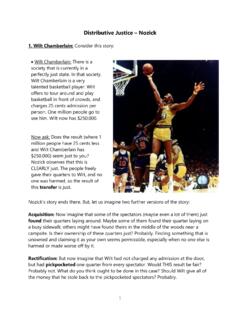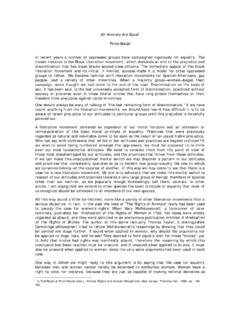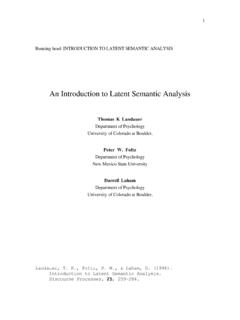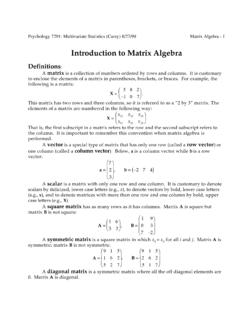Transcription of The Effectiveness of Class Size Reduction
1 Of 7 School of Education, university of colorado BoulderBoulder, CO 80309-0249 Telephone: s e aR c h- Ba s e d Op t iO n s FO R ed u c a t iO n pO l i c y m a k i n gThe Effectiveness of Class Size Reduction William J. Mathis, university of colorado BoulderJune 2016 Ask a parent if they want their child in a Class of 15 or a Class of 25. The answer is predictable. Intuitively, they know that smaller classes will provide more personalized attention, a better climate, and result in more learning. Ask teachers, and they will wax eloquent on the im-portance of small classes in providing individual support to their students. But ask a school board or district administrator, contending with a tight budget. They ask if the average Class size can be a bit bigger. Teacher pay and benefits are the largest single school expenditure, representing 80% of the nation s school Thus, small Class size is a costly, important, contentious and pe-rennial Research on Class SizeThere are many studies of the impact of smaller classes and they vary widely in As a result, proponents from all perspectives can cherry-pick studies that support their point of let s look closer.
2 There is, in fact, an independent consensus on what we know:This material is provided free of cost to NEPC s readers, who may make non-commercial use of the material as long as NEPC and its author(s) are credited as the source. For inquiries about commercial use, please contact NEPC at of 7 One of the earliest influential meta-studies was by Glass and Smith in They statisti-cally analyzed 300 reports involving almost 900,000 students. Once the Class size fell below about 15, learning increased progressively as Class size became smaller. The most prominent study supporting smaller Class sizes was the Tennessee STAR (Student/Teacher Achievement Ratio) experiment. The STAR experiment was a four-year statewide random-assignment experiment. Students in Kindergarten in the same schools were ran-domly assigned to classes of 13-15; to classes of 22-25 with a teacher s aide; or to classes of 25 without a teacher s aide.
3 In the early studies, these students were followed through grade 3. In practice, the small classes ranged in size from 13-18 and the large classes from 22-28. It is worth noting that even the larger classes were smaller than most classes in those grades in Tennessee at the time. The smaller classes performed substantially better by the end of second grade in test scores, grades, and fewer disciplinary The gains lasted. The students that had been assigned to smaller classes were more likely to graduate in four years, more likely to go to college, and more likely to get a degree in a STEM field. The positive effect was twice as large for poor and minority students, and thus narrowed the achievement gap. The original STAR study and follow-up reports, called the Lasting Benefits Studies, and subsequent Project Challenge 5 had an impact in the political arena. President Bill Clinton proposed a $12 billion Class size Reduction program in his 1998 State of the Union address that was subsequently adopted by Congress.
4 Molnar et al. (1996-2001), in a well-designed series of five annual evaluations of the Wis-consin SAGE (Student Achievement Guarantee in Education) Class size Reduction program utilizing a quasi-experimental design, reproduced the STAR With Class sizes of 15, they found significant and substantial effect sizes of standard deviations, indicating that Class size was a very effective school improvement strategy. Gains were greatest for Afri-can-American students, and teachers reported better classroom climates and fewer disci-pline problems. The continuation of small Class sizes into the higher grades increased its impact. But cost considerations resulted in Class size Reduction activities being concentrated in the lower grades, mostly among economically deprived and children of the years, Erik Hanushek of the Hoover Institute has taken a more skeptical look.
5 He performed a meta-analysis of 277 studies in 1997, claiming that Class size Reduction was not an effective school reform strategy. He argued that Class sizes have dropped over the last half of the twentieth century with no corresponding increase in achievement In summary, Surely Class size reductions are beneficial in specific circumstances for specific groups of students, subject matters, and teachers. Second, Class size reductions necessarily involve hiring more teachers, and teacher quality is much more im-portant than Class size in affecting student outcomes. Third, Class size Reduction is very expensive, and little or no consideration is given to alternative and more productive uses of those (p. 5)Hanushek s analysis was criticized on methodological grounds in that he gave more weight to studies that showed no impact from lowering Class size, while also treating weak studies as equivalent to those that were experimental and/or of much higher quality.
6 He was also questioned about his claim that teacher quality was more important than Class size in affect-ing student outcomes. Moreover, in re-analyzing the Tennessee STAR data, Alan Krueger not only concluded that Class size Reduction had economic benefits that outweighed the costs, and even within the large cohort of 22 to 25 students, the smaller the Class , the better of 7the student Mosteller also reported sustained effects and the effect size for mi-norities was about double that for majorities. 11 Krueger noted, as have many others, that Class size Reduction most benefits minority and disadvantaged students, and would be expected to narrow the racial achievement gap by about one-third. He also estimated that the economic gains of smaller classes in the early grades outweighed the costs two to While experimental studies have not been done for the middle and upper grades, there are many controlled studies, including longitudinal studies, showing gains in student outcomes for smaller classes at these grade Many of these studies also show improvements in student engagement, lower drop-out rates and better non-cognitive skills.
7 One longitudinal study revealed that smaller classes in eighth grade led to improvements in persistence and self-esteem, and that for urban schools, the economic benefits from investing in smaller classes would likely save nearly twice the cost. A study done for the US Department of Education analyzed the achievement levels of stu-dents in 2,561 schools, as measured by performance on the NAEP (national) exams. After controlling for student background, the only objective factor found to be positively correlat-ed with student performance was Class size. Student achievement was even more strongly linked to smaller classes in the upper In recent work (2015), Jackson, Johnson and Persico investigated the effects of school fi-nance reform in 28 states. They followed the infusion of new money between 1970 and 2010, and found, ..a 10% increase in per-pupil spending each year for all 12 years of public school leads to more completed years of education, percent higher wages, and a percentage-point Reduction in the annual incidence of adult poverty.
8 They concluded that the gains were achieved primarily by lower student-to-teacher ratios, increases in teacher salaries, and longer school years. Gains were strongest for economically disadvantaged chil-dren and were sufficient to eliminate from two-thirds to one hundred percent of the adult outcome gaps ( - wages, education level, percent in poverty) between those raised in poor and non-poor , the literature on Class size Reduction is clear and positive. The overwhelming ma-jority of peer-reviewed papers find it an effective Further Policy ConsiderationsSupply of Teachers An oft-heard reservation about Class -size Reduction is that there are not enough well-quali-fied teachers to make the system work. However, in California s billion dollar Class Size Re-duction initiative, achievement increased for all groups, but there was little or no evidence that the need to hire more teachers led to lower quality teachers in the long run.
9 When the Los Angeles Unified School District needed to triple its hiring of elementary teachers fol-lowing the state s Class -size Reduction initiative, there was no Reduction in mean teacher In addition, some studies point to lower teacher attrition rates when Class sizes are reduced, which would likely lead to a more experienced and effective teaching force of 7 Wash-Out Effects Most of the research has been conducted in the early grades (K-3). This led some to ques-tioning whether the effects are lasting or are Though Harris contended the effects wash out by seventh grade,20 Krueger and Schanzenbach found gains in college en-trance exams and especially among minority students. In fact, they concluded that small classes through eighth grade cut the achievement gap by 54%.21 Dynarski, et al. found gains in college attendance, graduation rate, and a higher likelihood of graduating with a STEM Jackson, Johnson and Persico found sustained long-term social and economic ef-fects in their 28-state work.
10 Chetty, et al found that students from smaller classes in kin-dergarten had a greater likelihood of attending college, owning a home and holding a 401K more than 20 years EffectsIn addition to the gains listed above, college attendance, graduation rate, student engage-ment, persistence and self-esteem is reported as The gains in test scores are at-tributed to the greater individualization of instruction, better classroom control and, thus, better climate. Teachers have more time for individual interactions with children, consult-ing with parents, and giving greater attention to grading Compared to Other ReformsThere is little evidence indicating that other reforms would be more effective at a lower While teacher quality is undoubtedly important, those who argue that improving teacher quality would be more cost-effective present no comparative data from experimen-tal or controlled studies.








